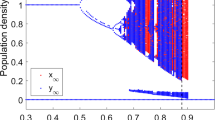Abstract
Various dynamical models have been suggested by demographers to understand or to better forecast fertility fluctuations. Usual linear techniques have proved poor, but nonlinear techniques may help us to find out some temporal qualitative structure, and to take into account breakdown phenomena. For instance, the 1931–1985 fluctuations may be better described by drawing first return functions, which show a precise qualitative behaviour: two attractors exchanging the trajectory in the phase space under the perturbing environment of the historical context. A second example is drawn from a 17th century population, at a time when people were submitted to high and very irregular mortality. Because of the stochastic nature of the process, attractors are difficult to determine, and we resort to tools which are different from usual asymptotic attractors. These tools, called confiners, are the stochastic analogue of the notion of attractor for stochastic dynamical processes. They have been defined by Cosnard and Demongeot on the basis of the set of accumulation points of the trajectory, and rely on the essential intuitive property of invariance through the double operation consisting first in searching the confining basin of a set, then in taking the limit of this basin. The notion of confiner enables a rigourous description of the equilibrium states of the process: For fertility fluctuations during the 17th century, it reveals two confining zones exchanging the trajectory. Moreover, a simulation system shows how the existence of these two zones are directly linked to the frequencyv of mortality crisis occurring, that is to say, according to the valuev, the population dynamics will more or less balance towards a resistance to the crisis or towards a usual renewal of the population.
Similar content being viewed by others
References
N.P. Bathia and G.P. Szegö,Dynamical Systems: Stability Theory and Applications, Vol. 35, Lecture Notes in Mathematics, ed. A. Wenig and K.F. Zimmermann (Springer, New York, 1967).
G.S. Becker and R.J. Barro, A reformulation of the economic theory of fertility, Quarterly J. Econ. 103(1988)1–25.
Benhabib and Nishimura,Endogeneous Fluctuations in the Barro-Becker Theory of Fertility ed. A. Wening and K.F. Zimmermann (Springer, Berlin, 1989).
J.N. Biraben and N. Bonneuil, Population et économie en Pays de Caux aux XVIe et XVIIe siècles, Population 6(1986)937–960.
G.D. Birkhoff,Dynamical Systems (AMS Colloq. Publ., New York, 1927).
N. Bonneuil, Conjoncture et structure dans les comportements de fécondité, Population 1(1989)135–157.
N. Bonneuil, Turbulent dynamics in a 17th century population, Math. Population Stud. 2(4)(1990)289–312.
J.-C. Chesnais,La Transition Démographique (P.U.F., 1986).
M. Cosnard and J. Demongeot, Attracteurs: une approche déterministe, C.R. Acad. Sci. 300(15)(1985).
J. Demongeot, M. Cosnard and C. Jacob,Attractors and Confiners: Deterministic and Stochastic Approaches (World Scientific, Singapore, 1986).
R.A. Easterlin,Birth and Fortune. The Impact of Numbers on Personal Welfare (Basic Books, New York, 1980).
G. Feichtinger,Demographische Analyse und populationdynamische Modelle. Grundzüge der Bevölkerungsmathematik (Springer, Wien, 1979).
G. Feichtinger, Limit cycles in Easterlin-type models, Math. Population Stud. 2(2)(1990)93–103.
J.V. Frauenthal, A dynamical model for human population growth, Theor. Pop. Biol. 8(1975).
J.V. Frauenthal and K.E. Swick, Limit cycle oscillations of the human population, Demography 20(1983)285–298.
L. Henry, Some data on natural fertility, Eugenics Quarterly 8(1961)81–91.
L. Henry and J. Houdaille, Age au premier mariage aux XVIIIe et XIXe siècles, Population 2(1979)403–441.
M.C. Kemp and H. Kondo, Overlapping generations, competitive efficiency and optimal population, Working Paper (1985).
R.D. Lee, The formal dynamics of controlled populations and the echo, the boom and the bust, Demography 11(4)(1974)563–585.
R. Lesthaeghe, A century of demographic and cultural changes: an exploration of underlying dimensions, Population and Development Rev. 9(3)(1983)411–436.
T.R. Malthus (ed.),An Essay on the Principle of Population, 1st. ed. (London, 1798).
G.A. Micheli, Exploring theoretical frameworks for the analysis of fertility fluctuations, Eur. J. Population 3(1987)177–201.
P.A. Samuelson, An economist's non-linear model of self-generated fertility waves, Population Stud. 30(1976).
S. Smale, Differentiable dynamical systems, Bull. AMS(1967)747–817.
K.E. Swick, Stability and bifurcation in age-dependent population dynamics, Theor. Population Biol. 20(1981)80–100.
F. Takens,On the Numerical Determination of Dimension of an Attractor, Vol. 1125, Lecture Notes in Mathematics (Springer, New York, 1985).
F. Takens,Detecting Strange Attractors in Turbulence, Vol. 898, Lecture Notes in Mathematics (Springer, 1981) pp. 366–381.
G.N. Von Tunzelmann,Malthus's Total Population System, Vol. 30, ed. Coleman and Wrigley (Basil Blackwell, New York, 1986).
K.W. Wachter and R.D. Lee, US births and limit cycles models, Demography 26(1)(1986)99–116.
Author information
Authors and Affiliations
Rights and permissions
About this article
Cite this article
Bonneuil, N. Attractors and confiners in demography. Ann Oper Res 37, 17–32 (1992). https://doi.org/10.1007/BF02071046
Issue Date:
DOI: https://doi.org/10.1007/BF02071046




